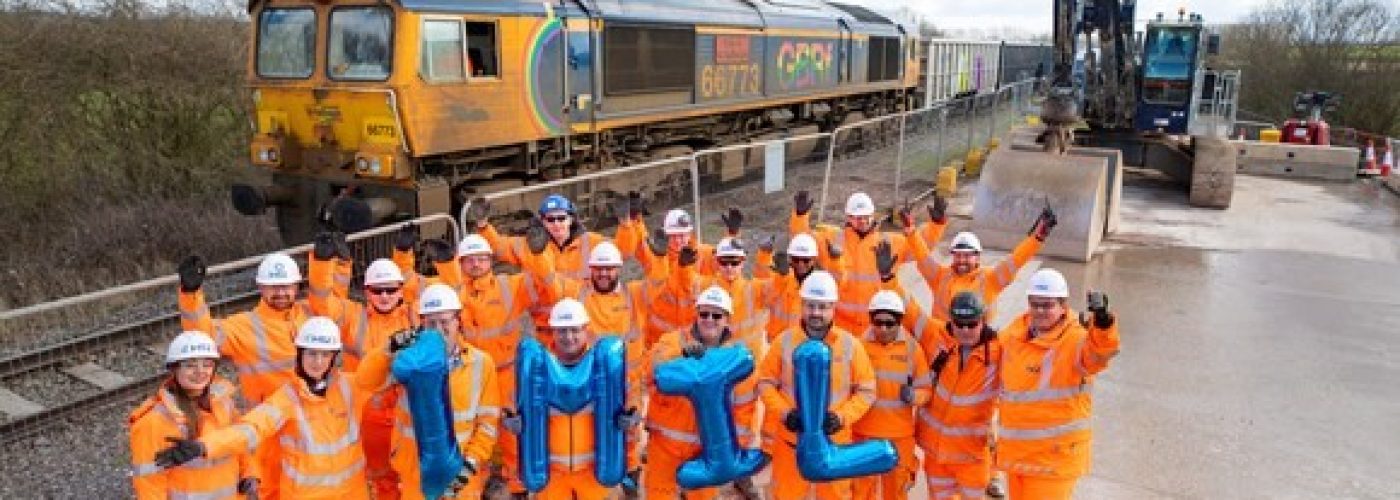646 freight trains deliver a million tonnes of construction materials to HS2’s Quainton railhead, near Aylesbury, over 16 months – taking the equivalent of more than 101,000 HGV journeys off local roads…
A small railhead near Quainton has helped HS2 take the equivalent of 101,000 HGV movements off local roads across Bucks, Oxfordshire and West Northants, it is revealed today.
The company building Britain’s new high-speed railway confirmed that its construction hub at Quainton, Bucks, has now received more than a million tonnes of construction material by rail carried by 646 trains – offsetting the need to transport the material by road.
Situated on an existing freight line north of Aylesbury, the railhead is expected to welcome an extra 1,400 freight trains over the next two years taking the total amount of material delivered to around 3 million tonnes.
This is on top of a million tonnes already delivered by rail to previous railheads in the local area, meaning that HS2 has now taken a combined total of two million tonnes of material or 217,000 HGVs off local roads and saved 22,378 tonnes of carbon, the equivalent of 22,300 single passenger flights from London to New York.
Once on site, most of the material – mainly aggregate used for construction – is stockpiled before being moved up or down the line of route of the new high-speed line on a series of dedicated haul roads to keep it away from local road users.
The HS2 project is fast approaching the peak of construction, with breakthrough on the longest tunnels earlier this week. Once complete, the railway will almost half journey times between London and Birmingham while freeing up space on the existing west coast mainline for more local services.
Welcoming the milestone, HS2 Ltd Senior Project Manager Ben Sebastian-Green said:
“We know that the local community are concerned about construction traffic, so it’s great to be able to get so much material into site by rail. Not only does it take traffic off local roads, but it also saves carbon and helps to streamline our logistics.
“Once complete, HS2 will improve journeys between London and Birmingham and free up space on the existing West Coast Mainline for more local services – and it’s great that, alongside delivering zero carbon journeys for passengers, we’re also cutting the amount of carbon in construction.”
The railhead is managed by HS2’s main works contractor EKFB – a team made up of Eiffage, Kier, Ferrovial Construction and Bam Nuttall. EKFB are delivering the central section of the project, including 15 viaducts, 81 bridges and two ‘green tunnels’.
They worked with a team from Network Rail who completed a series of alterations to enable freight services to operate in and out of the railhead at Quainton.
EKFB’s Head of Logistics and Security, Paul Bedford, said:
“Moving material by rail was always an essential part of our strategy to help deliver this project efficiently. The original strategy was to utilise existing railheads across neighbouring counties and move the material the last few miles to site by road. We quickly realised that there was an opportunity to establish our own railheads within the project area, and through the hard work of all involved, we turned this opportunity into a reality.
“The railheads are now taking large volumes of HGVs off the local road network, reducing our carbon footprint through fewer road journeys, and helping to generate significant financial savings by using a more cost-effective distribution system.”
The railhead is operated by Fishbone Solutions on behalf of EKFB with trains operated by DC Rail and GB Railfreight on behalf of Hanson.
Director at Fishbone Logistics, Paul Clews, commented:“What started with an initial trial of 100,000 Tonnes to the first railhead at Calvert North, the support and cooperation from EKFB, HS2, the quarry and the rail logistics supply partners, to deliver the two millionth ton to the fourth railhead at Quainton Road, has been a fantastic collaborative effort. Zero safety incidents, reduced carbon and transport costs, and more than 200,000 truck journeys taken off local roads is a great achievement by all involved.”
Building, Design & Construction Magazine | The Choice of Industry Professionals





